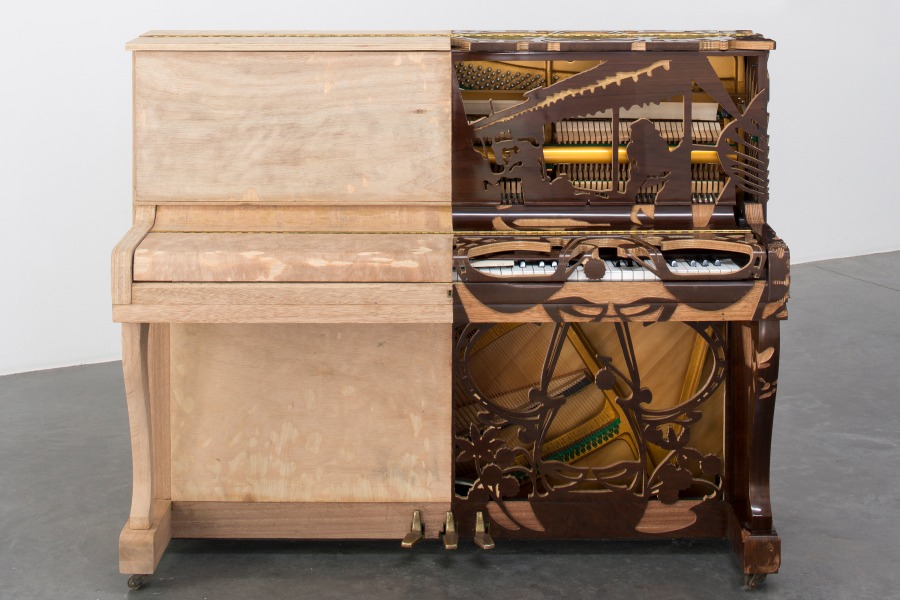Le Plateau FRAC Île-de-France
Paris (FR)
2014
“Interprète”
Group Show
Curator: Xavier Francesci
Press release by Xavier Francesci
Thu Van Tran is a Franco-Vietnamese who creates works associated with historical events which regularly explore notions of displacement, separation, mixture and precariousness. Arirang Partitions is an installation made up of a wooden piano and musical scores torn in two. The piano is completely sanded on the le side and worked in an artisanal way on the right side. With this work, Thu Van Tran transposes the history of the separation of Vietnam, after de-colonization, to the Korean context. The piano is accompanied by Arirang scores, popular music from the period when Korea was a single country. Today, both North and South Korea lay claim to this legacy. In the North, historical frescoes in the form of moving paintings, propaganda tools
of the party, are called arirang. For the South, Arirang has remained the popular song, but it is also a national TV channel and the name of a traditional cake. The “demi-scores” are played on the piano during the show, revealing the missing other half; this melody thus becomes the derisory anthem of a people reunited by being torn apart.
(...) It is ultimately a question of play, remake and transposition, beyond the fact of rendering the unintelligible intelligible. The different artistic projects have in fact been prepared on the basis of an already existing reality, which is then translated.
Beyond this guiding principle, however, the works on view distinguish themselves by the singular translation being offered to us. Here the performance is free and thoroughly personal, and thus truly meaningful. Therefore, even if we see an inherent paradox
–namely, that while we need the performer to be able to hear and understand the work, the act of interpretation moves us away from the truth– the paradox is as it happens, surpassed...
The other aspect uniting many of these works lies in the quintessential connection they have with music. It is clear that these ideas of play, version and remake reverberate like certain basic features of any musical work. Far from merely suggesting this close link, some of the works themselves aspire to the form of music, as they exist in the form of activation. The visual work, seemingly fixed once and for all, is now dreamt about as a piece to be enacted and re-enacted, and thus differently perpetuated. From the musical score to the conceptual procedure (and vice versa), there is but just one step: the artists easily cross the line to offer us pieces to be experienced and re-experienced.
In this spirit, Interprète. will propose a series of interventions and performances in counterpoint to the show. The set of works presented will thus form the basis of an orchestration in the making. “The exhibition” may be regarded as a fully-fledged medium. Interprète. is in this sense the broad instrument which must be played to get the full measure of it. A game permitting the spectator to make his or her own interpretation of things...
(...)

Arirang Partitions
(Piano and torn scores)
2009
Collection frac île-de-france

Arirang Partitions
(details torn scores)
2009
Collection frac île-de-france

Arirang Partitions
(torn scores)
2009
Collection frac île-de-france

Arirang Partitions
(Piano and half torn scores)
2009
Collection frac île-de-france

Arirang Partitions
(Piano and half torn scores)
2009
Collection frac île-de-france

Arirang Partitions
(Piano)
2009
Collection frac île-de-france

Arirang Partitions
(details of the piano)
2009
Collection frac île-de-france

Arirang Partitions
(Details of the piano and view of the exhibition Interprète)
2009
Collection frac île-de-france

Arirang Partitions
(Piano)
2009
Collection frac île-de-france

Arirang Partitions
(Piano and half torn scores performed)
2009
Collection frac île-de-france

Arirang Partitions
(Piano and half torn scores performed)
2009
Collection frac île-de-france

Arirang Partitions
(Piano and half torn scores performed)
2009
Collection frac île-de-france

Arirang Partitions
(Piano and half torn scores performed)
2009
Collection frac île-de-france

Arirang Partitions
(Piano and half torn scores performed)
2009
Collection frac île-de-france

Arirang Partitions
(Piano and half torn scores performed)
2009
Collection frac île-de-france

Arirang Partitions
(Piano and half torn scores performed)
2009
Collection frac île-de-france

Arirang Partitions
(Piano and half torn scores performed)
2009
Collection frac île-de-france